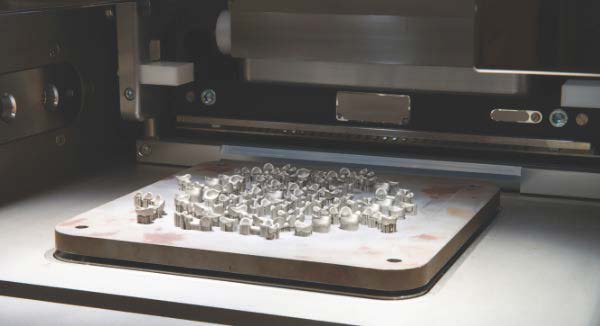
3D printing community responds to COVID-19
3D printing community responds to COVID-19
“In this COVID-19 crisis, the 3D printing industry has demonstrated its on-demand production potential. However, the crisis also highlighted the rigorous nature of state-of-the-art manufacturing requirements in the medical industry, device specific regulations and also the lack of 3D printing contract manufacturers which are able to fulfill regulatory requirements. To address this, TÜV SÜD has published 3D printing checklists, supporting manufacturers to navigate the regulatory landscape. "
Mr. Gregor Reischle
Head of Additive Manufacturing, Global Industrial AM Team, TÜV SÜD
Thursday, 17 September 2020
Albert Einstein once said, "In the midst of every crisis, lies great opportunity." At a time when the world is combating the novel coronavirus, Additive Manufacturing (AM), a transformative technique of layering that creates strong yet light products, commonly known as 3D printing, has emerged as an essential technology to augment the supply of essential medical supplies .
Even before the COVID-19 pandemic, analysts have reported that the direct market for additive manufacturing will grow at least $ 20 billion in value by 2020. The overall economic impact created by the sector could be higher, reaching $ 100 billion to $ 250 billion by 2025 if adoption rates persist at current rates [1] . This robust growth is driven by various applications of additive manufacturing including the production of vehicular parts in the aerospace and automotive sectors. In the energy sector, 3D printing techniques have increased the efficiency of repairing burner heads attached to gas turbines - reducing duration of repairs by up to 11 times1. In the medical field, additive manufacturing is expected to grow exponentially as well. For instance, in the dentistry sector, 3D printing is expected to grow by US $ 9.7 billion by 2027, an impressive 35 per cent growth year-on-year [2] .
With national borders closing to contain the spread of COVID-19, companies are forced to rethink and transform their traditional supply chain models. The global community of additive manufacturers and designers have responded quickly to the crisis by volunteering their skills and pooling together resources to ease pressures on supply chain and governments.
The initial focus is to use 3D printing techniques to bridge the gap in the supply chain of nasal swabs, ventilators components as well as Personal Protective Equipment (PPE) such as masks and face shields. To facilitate the knowledge gap in the industry, several platforms have been set up by government and industry associations, multinationals and start-ups, such as:
The development of an AM checklist for face shields is a good case in point. In the light of the global shortage for surgical masks, there is an increasing demand for face shields for healthcare workers. 3D printing can be applied in the production mix to increase supply locally. However, 3D printing companies require guidance on the safety requirements of face shields. As face shields used in hospitals are classified as PPE, full conformity assessments will apply and takes considerable time to complete.
In Singapore, TÜV SÜD participated in a multi-agency tie-up with the Health Science Authority, Nanyang Technological University (NTU) and NAMIC to co-develop an AM checklist for medical AM parts to help manufacturers navigate through the testing requirements and mitigate regulatory non-compliance risks. Checklists for face shields as well as nasal swabs are publicly available for free through the NAMIC’s COVID-19 response platform. As an independent third party, TÜV SÜD supports the manufacturers with testing services to verify / ensure quality and consistency for industrial AM production according to pre-defined test requirements and schemes. However, it is important to note that the tests and assessments performed would not constitute a certification of medical devices.
These platforms have led to an unprecedented proliferation of knowledge across the entire 3D printing network. Such knowledge-sharing and collaboration will have a lasting positive impact in propelling the development of 3D printing technologies.
A distinct advantage of additive manufacturing is the ability to rapidly produce prototypes in a time and cost-efficient manner thereby shortening the development cycle of medical devices. During a pandemic, the ability to produce on short notice and at a variable production capacity are important in plugging gaps in the supply of medical devices.
Devices produced by additive manufacturing must also meet compliance and safety standards just like any other devices which are sold in the market. “In this COVID-19 crisis, the 3D printing industry has demonstrated its on-demand production potential. However, the crisis also highlighted the rigorous nature of state-of-the-art manufacturing requirements in the medical device industry, device specific regulations and the lack of 3D printing contract manufacturers which are able to fulfil the regulatory requirements. To address this, TÜV SÜD has published 3D printing checklists, supporting manufacturers to navigate the regulatory landscape and to support the implementation of AM standards, as well as the resulting AM specific technological risks” commented Gregor Reischle, Head of Additive Manufacturing, Global Industrial AM Team, TÜV SÜD.
The checklist includes a list of the most important standards and regulations – both general and AM-specific. International standard organisations such as ASTM International and ISO are providing free access to the important standards used in the production and testing of PPE and medical devices to support manufacturers, test labs, healthcare professionals and the general public.
The intended use of the product also determines the kind of regulation the item must comply with. For example, if the device is classified as PPE, which protects user from particles, droplets or other harm, then the PPE-Regulation (Regulation (EU) 2016/425) has to be applied. Dr Royth von Hahn, Senior Vice President, Medical and Health Services notes, “If the intended use is not a PPE, then other product specific regulations may apply.”
Medical devices must be high-quality, high-performing, and safe for the patient, so they will not fail or lead to injuries. Medical devices which are produced using 3D printing are subjected to the same stringent standards required for all medical devices in the market. Both legal manufacturers and contract manufacturers providing outsourced production using AM would require the services of independent third-party organisations like TÜV SÜD to test and certify the product.
For the healthcare industry, the application of additive manufacturing also coincides with a broader pivot in the medical industry from generalised care to personalised solutions, enabling the production of highly precise and personalised medical devices particularly for niche market segments. The advantage of additive manufacturing is the potential to create complex and functional designs that do not require parts assembly. This increases the quality of the customised products and can have far-reaching benefits for sections of society.
Last year, TÜV SÜD has signed a Memorandum of Understanding (MoU) with the NUS Centre for Additive Manufacturing (AM.NUS) at the National University of Singapore (NUS). This MoU will promote research and development activities in the area of 3D printed biomedical metal implants for clinical trials.
The work that AM.NUS is doing pushes the boundaries of medical device production, and potentially revolutionises and improves access to healthcare in developing countries. Before AM.NUS can start producing biomedical implants, it would first need to obtain the ISO 13485 certification. That’s where TÜV SÜD comes in. TÜV SÜD will audit AM.NUS against the ISO 13485 standards and the published 3D printing checklist including the DIN SPEC 17071. This way AM.NUS gets an assessment to which extent its quality assurance meets not only ISO 13485 but also the specific criteria established for 3D printing. Upon successful audit, an ISO 13485 certification as well as an IAM production site certification will be awarded. This will pave the way for AM.NUS to fabricate 3D printed metal implants, undergo clinical trials and obtain the required certification and compliance in accordance with global standards.
The TÜV SÜD industrial quality programme for AM manufacturers aims to accelerate the quality growth journey of AM manufacturers and is aligned with the capability development objectives of NAMIC and Enterprise Singapore (ESG). Manufacturers who are keen to adopt new technologies, innovate processes and improve their quality management system can possibly seek funding opportunities under the Enterprise Development Grant offered by ESG.
The successful application of 3D printing in pandemic relief is expected to make a positive impact on the medical and healthcare industry by enhancing the community’s drive for innovation. Industry players will also see greater value in leveraging AM to produce highly precise and personalised devices in targeted segments of the industry. AM can potentially diversify a firm’s manufacturing mix and reduce its dependence on traditional supply chains. “Adding AM machines to the production floors will enable companies to transform faster and enable integrated supply chain networks. Production on demand and nearshoring using 3D printing is sustainable and has proven to be effective by many manufacturers round the globe during the COVID-19 crisis. 3D printing used for production of end use parts is the new normal,” concluded Reischle.
[1] McKinsey and Company: Additive Manufacturing: A long-term game changer for manufacturers
[2] 3D Natives: The growing market for additive manufacturing in the medical sector


Safeguarding customers and employees globally
Learn More
Site Selector
Global
Americas
Asia
Europe
Middle East and Africa